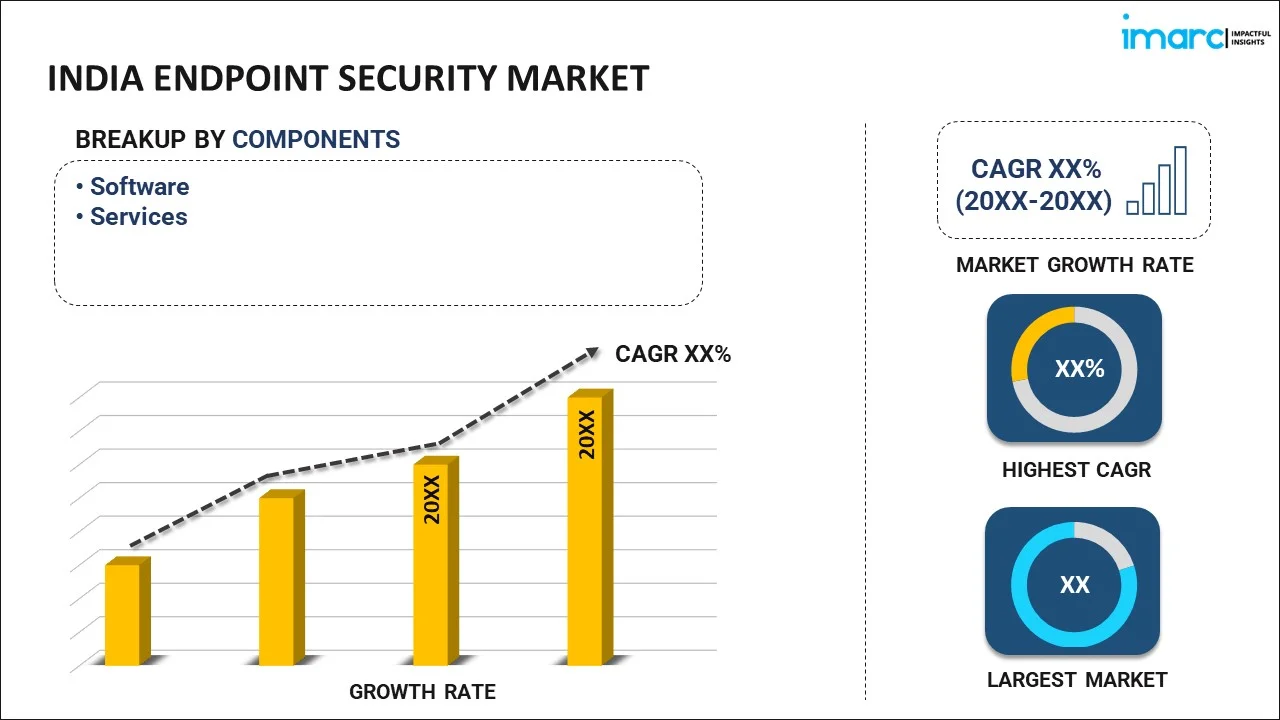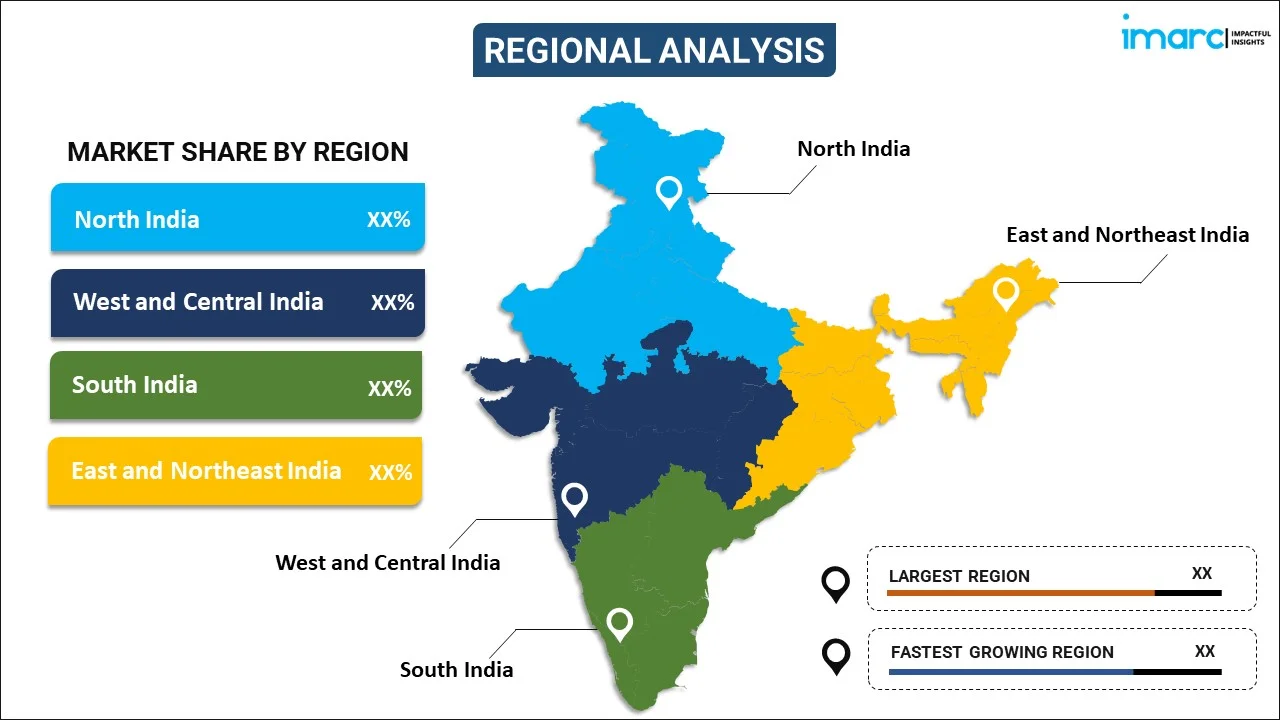
India Endpoint Security Market Report by Component (Software, Services), Deployment Mode (On-premises, Cloud-based), Organization Size (Large Enterprises, Small and Medium-sized Enterprises), Vertical (Banking, Financial Services and Insurance (BFSI), IT and Telecommunications, Government and Defense, Healthcare and Life Sciences, Manufacturing, Retail and E-Commerce, and Others), and Region 2025-2033
Market Overview:
India endpoint security market size reached USD 646.6 Million in 2024. Looking forward, IMARC Group expects the market to reach USD 1,558.7 Million by 2033, exhibiting a growth rate (CAGR) of 9.5% during 2025-2033. The increasing shift towards remote work, which has accelerated the need for endpoint security to prevent data breaches and unauthorized access, is driving the market.
|
Report Attribute
|
Key Statistics
|
|---|---|
|
Base Year
|
2024
|
|
Forecast Years
|
2025-2033
|
|
Historical Years
|
2019-2024
|
|
Market Size in 2024
|
USD 646.6 Million |
|
Market Forecast in 2033
|
USD 1,558.7 Million |
| Market Growth Rate 2025-2033 | 9.5% |
Endpoint security refers to the protection of devices or endpoints, such as computers, laptops, mobile devices, and servers within a network, from potential security threats. It is a crucial component of an organization's overall cybersecurity strategy, aiming to safeguard the entry points or endpoints where data is accessed and transmitted. Endpoint security solutions encompass various tools and technologies, including antivirus software, firewalls, intrusion detection systems, and encryption mechanisms. The primary goal is to detect, prevent, and respond to malicious activities such as malware, ransomware, and unauthorized access, ensuring the integrity and confidentiality of sensitive information. With the increasing sophistication of cyber threats, robust endpoint security is essential for maintaining a secure and resilient IT infrastructure, protecting both individual devices and the entire network from potential breaches and data compromises.
India Endpoint Security Market Trends:
The endpoint security market in India is propelled by several factors that collectively shape the landscape of cybersecurity. Primarily, the escalating frequency and sophistication of cyber threats necessitate robust endpoint security solutions. As cyber adversaries continuously evolve their tactics, organizations are compelled to invest in advanced technologies to safeguard their endpoints. Furthermore, the growing trend of remote work accentuates the significance of endpoint security, as a dispersed workforce increases the vulnerability of endpoints to diverse cyber risks. Moreover, the regulatory landscape plays a pivotal role in driving the endpoint security market forward. Stricter data protection regulations and compliance requirements mandate organizations to implement comprehensive endpoint security measures to ensure the confidentiality and integrity of sensitive information. In tandem with this, the rapid proliferation of connected devices in the Internet of Things (IoT) era amplifies the attack surface, prompting businesses to adopt robust endpoint security solutions to mitigate potential risks. Additionally, the increasing awareness among enterprises about the financial and reputational consequences of security breaches is a key driver. Organizations are recognizing the critical role of endpoint security in safeguarding their digital assets and maintaining the trust of their stakeholders. Collectively, these drivers underscore the imperative for organizations to stay abreast of evolving threats and deploy cutting-edge endpoint security solutions to fortify their cyber defenses.
India Endpoint Security Market Segmentation:
IMARC Group provides an analysis of the key trends in each segment of the market, along with forecasts at the country level for 2025-2033. Our report has categorized the market based on component, deployment mode, organization size, and vertical.
Component Insights:

- Software
- Services
The report has provided a detailed breakup and analysis of the market based on the component. This includes software and services.
Deployment Mode Insights:
- On-premises
- Cloud-based
A detailed breakup and analysis of the market based on deployment mode have also been provided in the report. This includes on-premises and cloud-based.
Organization Size Insights:
- Large Enterprises
- Small and Medium-sized Enterprises
The report has provided a detailed breakup and analysis of the market based on the organization size. This includes large enterprises and small and medium-sized enterprises.
Vertical Insights:
- Banking, Financial Services and Insurance (BFSI)
- IT and Telecommunications
- Government and Defense
- Healthcare and Life Sciences
- Manufacturing
- Retail and E-Commerce
- Others
A detailed breakup and analysis of the market based on vertical have also been provided in the report. This includes banking, financial services and insurance (BFSI), IT and telecommunications, government and defense, healthcare and life sciences, manufacturing, retail and e-commerce, and others.
Regional Insights:

- North India
- West and Central India
- South India
- East and Northeast India
The report has also provided a comprehensive analysis of all the major regional markets, which include North India, West and Central India, South India, and East and Northeast India.
Competitive Landscape:
The market research report has also provided a comprehensive analysis of the competitive landscape in the market. Competitive analysis such as market structure, key player positioning, top winning strategies, competitive dashboard, and company evaluation quadrant has been covered in the report. Also, detailed profiles of all major companies have been provided.
India Endpoint Security Market Report Coverage:
| Report Features | Details |
|---|---|
| Base Year of the Analysis | 2024 |
| Historical Period | 2019-2024 |
| Forecast Period | 2025-2033 |
| Units | Million USD |
| Scope of the Report | Exploration of Historical and Forecast Trends, Industry Catalysts and Challenges, Segment-Wise Historical and Predictive Market Assessment:
|
| Components Covered | Software, Services |
| Deployment Modes Covered | On-premises, Cloud-based |
| Organization Sizes Covered | Large Enterprises, Small and Medium-sized Enterprises |
| Verticals Covered | Banking, Financial Services and Insurance (BFSI), IT and Telecommunications, Government and Defense, Healthcare and Life Sciences, Manufacturing, Retail and E-Commerce, Others |
| Regions Covered | North India, West and Central India, South India, East and Northeast India |
| Customization Scope | 10% Free Customization |
| Post-Sale Analyst Support | 10-12 Weeks |
| Delivery Format | PDF and Excel through Email (We can also provide the editable version of the report in PPT/Word format on special request) |
Key Questions Answered in This Report:
- How has the India endpoint security market performed so far and how will it perform in the coming years?
- What has been the impact of COVID-19 on the India endpoint security market?
- What is the breakup of the India endpoint security market on the basis of component?
- What is the breakup of the India endpoint security market on the basis of deployment mode?
- What is the breakup of the India endpoint security market on the basis of organization size?
- What is the breakup of the India endpoint security market on the basis of vertical?
- What are the various stages in the value chain of the India endpoint security market?
- What are the key driving factors and challenges in the India endpoint security?
- What is the structure of the India endpoint security market and who are the key players?
- What is the degree of competition in the India endpoint security market?
Key Benefits for Stakeholders:
- IMARC’s industry report offers a comprehensive quantitative analysis of various market segments, historical and current market trends, market forecasts, and dynamics of the India endpoint security market from 2019-2033.
- The research report provides the latest information on the market drivers, challenges, and opportunities in the India endpoint security market.
- Porter's five forces analysis assist stakeholders in assessing the impact of new entrants, competitive rivalry, supplier power, buyer power, and the threat of substitution. It helps stakeholders to analyze the level of competition within the India endpoint security industry and its attractiveness.
- A competitive landscape allows stakeholders to understand their competitive environment and provides an insight into the current positions of key players in the market.
Need more help?
- Speak to our experienced analysts for insights on the current market scenarios.
- Include additional segments and countries to customize the report as per your requirement.
- Gain an unparalleled competitive advantage in your domain by understanding how to utilize the report and positively impacting your operations and revenue.
- For further assistance, please connect with our analysts.
 Inquire Before Buying
Inquire Before Buying
 Speak to an Analyst
Speak to an Analyst
 Request Brochure
Request Brochure
 Request Customization
Request Customization




.webp)




.webp)












